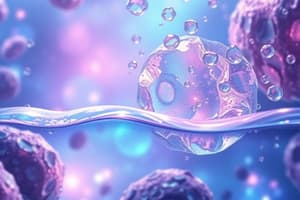Podcast
Questions and Answers
If a cell is placed in a solution with a higher solute concentration than the cell's internal environment, what will happen to the cell?
If a cell is placed in a solution with a higher solute concentration than the cell's internal environment, what will happen to the cell?
- The cell will burst due to an influx of water.
- The cell will swell due to water moving into the cell.
- The cell will maintain its shape because water will move in and out at equal rates.
- The cell will shrink due to water moving out of the cell. (correct)
Which of the following statements correctly describes the relationship between solute concentration and water potential?
Which of the following statements correctly describes the relationship between solute concentration and water potential?
- Water potential is always positive, regardless of solute concentration.
- Increasing solute concentration increases water potential.
- Solute concentration has no effect on water potential.
- Increasing solute concentration decreases water potential. (correct)
A plant cell is placed in a solution with a water potential of -0.5 MPa. The cell's internal water potential is -0.8 MPa. In which direction will water move?
A plant cell is placed in a solution with a water potential of -0.5 MPa. The cell's internal water potential is -0.8 MPa. In which direction will water move?
- There will be no net movement of water because the water potentials are equal.
- Water will move out of the cell into the solution.
- Water will move into the cell from the solution. (correct)
- Water will move in both directions at an equal rate.
What is the osmotic pressure of a solution containing 0.2 moles of a non-dissociating solute in 1 liter of water at 25°C?
What is the osmotic pressure of a solution containing 0.2 moles of a non-dissociating solute in 1 liter of water at 25°C?
Which of the following scenarios would result in a negative pressure potential?
Which of the following scenarios would result in a negative pressure potential?
Flashcards
Osmosis
Osmosis
Passive diffusion of water from high to low concentration.
Hypertonic Solution
Hypertonic Solution
Solution with high solute concentration; water moves out of the cell.
Hypotonic Solution
Hypotonic Solution
Solution with low solute concentration; water moves into the cell.
Isotonic Solution
Isotonic Solution
Signup and view all the flashcards
Water Potential (
Ψ)
Water Potential ( Ψ)
Signup and view all the flashcards
Study Notes
Movement of Water
- Osmosis is a passive form of diffusion
- Water moves from high to low concentration
- Water moves across cell membranes
- Osmosis is driven by the difference in water potential between two areas
- Water moves to equalize the concentration of solutes
Types of Solutions
- Hypotonic solution: Contains a lower concentration of solutes compared to the inside of a cell. Water will move into the cell, causing it to swell.
- Hypertonic solution: Contains a higher concentration of solutes compared to the inside of a cell. Water will move out of the cell, causing it to shrink.
- Isotonic solution: Contains the same concentration of solutes as the inside of a cell. Water moves in and out at equal rates, maintaining cell shape.
Water Potential
- Water potential is the tendency of water to move from one area to another.
- Water potential is affected by solute concentration and pressure.
- Pure water has a water potential of zero.
- Adding solutes lowers water potential.
- Pressure increases water potential.
- The water potential equation: Ψ = Ψs + Ψp
- Ψ = water potential
- Ψs = solute potential
- Ψp = pressure potential
Ideal Gas Law & Osmosis Relationships
- Ideal gas law: π = iCRT
- π = osmotic pressure
- i = ionization constant
- C = concentration
- R = ideal gas constant
- T = temperature.
- Zero pressure is only for closed systems. Open systems have zero pressure.
Studying That Suits You
Use AI to generate personalized quizzes and flashcards to suit your learning preferences.




